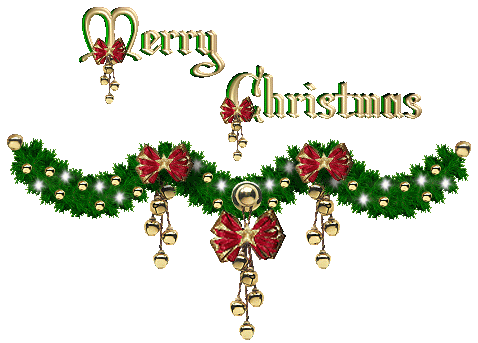
Between the 6th December and the 13th January there are some wonderful Christmas customs carried out all over the world! Click on the flags to find out what the people of that country do during the Christmas season!
Christmas in Australia and New Zealand comes in the middle of their summer - no white Christmas for them! Most of the time it is blue skies, bright sunshine and temperatures in the eighties (25 C) and above.
The first official Australian Christmas was celebrated on 25 December 1788 at Sydney Cove by Reverend Johnson. Following the service Arthur Phillips, the Governor, presided over a traditional Christmas meal with his officers ending with a loyal toast to King George III. However, there was no special meal for the convicts - they had to make do with their normal rations of bread.
Preparation for Christmas starts in early December when decorations are put up, including door wreaths, artificial trees and nativity scenes. Christmas cards with designs similar to those found in the UK and US (holly, snow scenes, Dickensian Christmas scenes etc) are sent out to family and friends. In many homes, Christmas cakes and puddings will be baked ready to eat on Christmas Day. In the cities and towns, many shopping centres and stores have their own 'Santa' for children to meet.
Because it is so warm at this time, flowers tend to be the main form of decoration, particularly the native Christmas Bush (a plant which has little red flowered leaves) and Christmas Bell. However, some people do have a real tree with lights and decorations, which are put up just before Christmas Eve.
Christmas carols are played throughout the country - traditional songs such as 'Once in Royal David's City' and 'Little Town of Bethlehem' as well as typically Aussie songs such as 'Six White Boomers', 'The North Wind' and 'The Carol of the Birds'. Bing Crosby's 'White Christmas' is also popular down under!
'Carols by Candlelight' is a tradition which started in 1937. It is held every year on Christmas Eve at the Myer Music Bowl, Melbourne when thousands of people gather to sing their favourite Christmas songs, lighting up the night sky with candles. This is now broadcast throughout the world.
In the run up to Christmas there are many professional and amateur productions of Handel's Messiah performed throughout country. One version in particular is that presented by Radio Community Chest in Sydney Town Hall - a tradition that has taken place for over 50 years, with proceeds going to those in need. A choir of over 500 is drawn from churches throughout Sydney.
The school summer holidays start a week before Christmas with children being off until after Australia Day on 26 January. This is a time when exams are over and results are eagerly awaited!
Many people will attend the midnight service on Christmas Eve before returning home to wait for Father Christmas/Santa Claus to come and leave presents under tree. Before they go to bed, children leave out a glass of milk or coke for him and some carrots for his reindeer.
Christmas Day is a time for families to get together and exchange gifts before either going to church or having their Christmas lunch. Until recently this would have been a traditional meal of turkey, cranberry sauce, ham, pork and vegetables followed by a flaming Christmas pudding with brandy sauce. However, due to the diversity of cultures within Australia, and the fact that the weather is so hot at this time of year, many people now have cold meat or seafood with salads and it is often taken as a picnic either to the country or to the beach.
In some parts of Australia there is a new tradition beginning to take hold - that of 'Christmas in July', which is the coldest month of the year as it is in the middle of their winter. Temperatures are still well above freezing but it is cooler than it is in December! This is when families will gather together and have the traditional Christmas meal together with all the trimmings such as including party hats and streamers
Boxing Day is a public holiday in Australia and many people either relax and watch the annual Boxing Day Test Match or begin travelling to their holiday destinations. Boxing Day also marks the beginning of the Sydney to Hobart yacht race.

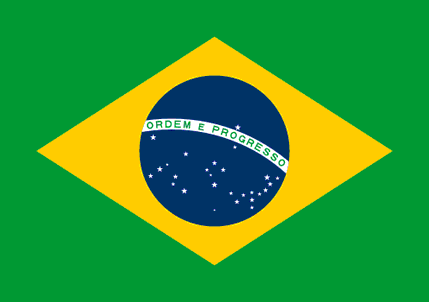
Boas Festas e Feliz Ano Novo
Brazil is a mix of people from many parts of the world - especially Portugal from which many of their traditions originate. One of these is the 'Presépio' or Nativity scene (from the Hebrew word 'presepium' meaning the bed of straw in which Jesus first slept after birth) which was introduced in the 17th century by a Franciscan friar named Gaspar de Santo Agostinho. They can be seen in churches, houses and stores throughout the country during December and the beginning of January.
The weather in Brazil is very hot at this time of year as it is their summer.
However, many people represent the falling snow by putting little pieces of cotton
wool on pine trees. They also put lights and decorations on trees and sing carols
with friends and families.
On Christmas Eve the meal is laid out before people attend the 'Missa do Galo'
(Mass of the Rooster) at midnight, so that the Holy family may eat if they wish.
There is a variety of food which reflects the different cultures within Brazil - turkey, chicken, ham, coloured rice, salad and fresh or dried fruit.
Port and beer are drunk with the meal.
The meal is eaten after the service, with the children being served first so that they can go to sleep in order for Papai Noel to fill their shoes with gifts and sweets. Because of the heat Papai Noel has to wear silk clothing as his usual heavy clothes would be too warm for him.
On Christmas morning, after church, families get together and exchange
their gifts and presents.

Glaedelig Jul
Before Christmas the streets and shops are elaborately decorated with greenery and the Danish symbol of Christmas - red and white paper hearts. Most people have small outdoor trees which they decorate with lights and hearts. Inside they will have red and white candles on the dinner table and there will be Christmas hearts everywhere. 'Kravlenisser' (Christmas figures), which are made of thick card, are also often placed around the house. Warm dough balls and Christmas cookies are served with glasses of glogg (mulled wine).
As in other Scandinavian countries, Denmark has also adopted the tradition of celebrating the Lucia Bride on 13 December. On this day there are a number of processions of young girls, each of them carrying a candle and singing the Lucia song. The procession is headed by the 'bride' who has candles in her hair. These days battery powered candles are usually used for safety!
Candles play a large part in the preparations for Christmas - with the Advent wreath, which has four candles to represent the four Sundays in Advent, or the Advent candle which has 24 numbers on it and is burned each day to countdown to Christmas.
Christmas itself is celebrated on the evening of 24 December. The indoor tree is put up during the day and is decorated with small paper cases filled with sweets, glass baubles, paper hearts, lights and Danish flags. This is often done by one or two people and kept secret from the rest of the family. Gifts are placed under the tree ready to be opened after dinner.
Before sitting down to dinner a bowl of porridge must be left out for the 'nisse' - a small elf like creature, who wears a red cap and is said to live in the attic. This will ensure peace and prosperity for the coming year.
Dinner will consist of roast pork, goose or beef and dessert is always rice pudding (Julgrot) which has an almond hidden in it. Whoever gets the almond is said to have good luck throughout the new year and will often receive a special gift of marzipan or chocolate.
After dinner everyone is allowed to see the tree, which will be ablaze with lights. Carols are sung and the gifts are handed out.
Gifts are said to have been brought by Jul Mander who arrives in a sleigh drawn by reindeer. He is helped by elves called 'Jul Nisse' who are said to live in the attics. Before sitting down to dinner a bowl of porridge and some milk is left out for Jul Nisse.
On Christmas Day people visit family and friends before returning for a large lunch for the whole family with a range of dishes - similar to the Swedish smorgasbord.

Hauskaa Joulua
Christmas preparations begin early in Finland, with everyone cleaning their houses for the three holy days of Christmas. However, the official start to the Christmas season is the first Sunday in Advent, when Vogler's 'Hosianna' is played at church services and there are special Advent Concerts in the evening.
Christmas lights begin to appear in shops, offices and towns and advent decorations are brought out. Families count the days to Christmas with advent calendars and advent candles.
The celebration of St Lucia Day (13 December) was only introduced to Finland from Sweden in 1950 but has been widely adopted by Finnish families. Additionally, a national Lucia is chosen by public vote from a short list of ten teenage girls and December 13 marks her first official appearance, wearing a long white dress and a crown of lighted candles. Following this she pays visits to Christmas gatherings, hospitals and schools to spread her message of light, hope and charity.
On the final Sunday before Christmas, families start to look for their tree. This is usually brought into the house the day before Christmas and decorated with national flags and straw mobiles called 'himmeli'. The tree is then lit for the first time
Christmas Eve is the main highlight of the season and is a special day which begins with a breakfast of rice porridge and plum fruit juice. The morning is generally spent decorating the tree. Wherever possible, families get together and, at midday, the 'peace of Christmas' is broadcast on television and radio from Turku, the former capital of Finland. This marks the beginning of the festivities.
At about 5.00pm a church service is held and candles are placed on the graves of loved ones.
On their return home it is the time that all children are waiting for - the visit of Joulupukki (Father Christmas) who is believed to live in the northern part of Finland in Korvatunturi, north of the Arctic Circle. Often children will dress up as his helpers in red tights, long red cap and grey/red cotton suit.
After the gifts have been given out it is time for the traditional Christmas meal. This consists of a variety of dishes - ham or turkey with macaroni, rutabaga, carrot and potato which is followed by rice porridge and raisin soup.
On Christmas Day people generally attend a church service in the morning before spending the day with family and friends.
The Christmas holiday season continues until Twelfth Night on 6 January.
Christmas preparations begin with the cleaning up of homes, both outside and inside. Walls are painted, the lawn is cut and stones and tree trunks are whitewashed and people bake lots of cakes and puddings.
A pig or goat will be killed a few days before Christmas and the meat shared with the neighbours - often in return for whatever food they have to offer such as yams, fruits and vegetables.
Most traditional churches in Jamaica have carol services and Christmas cantatas (concerts). Young children act out the Christmas Story and the sharing of gifts in schools and Sunday School is also a feature of Christmas in Jamaica.
Although there is no snow in Jamaica, many streets, homes, shops and other public places are beautifully decked out with lights and other decorations.
The Grand Market is a particular Christmas custom in Jamaica. Main streets in major towns and the city of Kingston are closed and no traffic is allowed access. Sellers spread their goods out along the road and children browse with their parents, buying gifts for their family and friends.
On Christmas morning, after church, families will get together and Egg Punch, a traditional drink similar to Egg Nog is served. The main meal will consist of duck, ham, chicken, turkey, beef, lots of vegetables, salads and cakes.

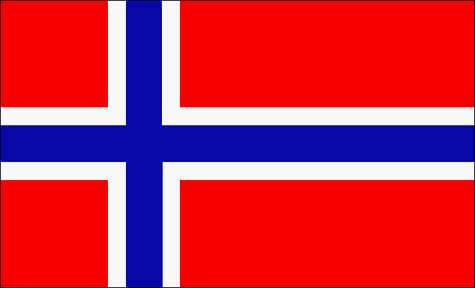
Gledelig Jul
Since ancient times Norwegians have celebrated midwinter with parties and feasts to mark the transition from the dark winter to the light of spring and summer. However, during the 10th century King Haakon decided that the pagan custom of celebrating Jul (Yule) would be moved to 25 December and would celebrate the birth of Jesus. Over the years this has gradually moved from being a pagan festival to being a Christian festival instead. However, many of the traditions have remained.
Preparations for Christmas begin on the first Sunday in Advent when outdoor trees are lit. Decorations, biscuits and sweets are made by families and there are a number of Christmas Markets held.
On 13 December there are a number of St Lucia Day processions, each of which is led by a young girl in a white robe, with a crown of lights on her head and a candle in her hand.
At 5 p.m. on Christmas Eve the church bells 'ringe in Julen' (ring in Christmas) throughout the country. This is the real start to Christmas celebrations. Most people attend a church and after the service they return home to eat a bowl of porridge with butter, sugar and cinnamon. Before the family sit down to eat this, the tradition is to put out a bowl of porridge for the nisse (gnome).
After the meal the indoor tree is lit and Julenissen arrives with a sack full of gifts from Santa. Julenissen is usually depicted with a long white beard and red stocking cap, wearing knee breeches, hand knitted stockings, a Norwegian sweater and a homespun jacket. This is topped by a heavy fur coat. Once all the presents have been distributed and have been opened everyone sits down for coffee and cakes.
Christmas Day starts with a church service. This is followed by the Christmas Buffet which includes such food as pork, lamb, cold meats, lutefisk, herring, trout, salmon, cheese, fruit, cloudberry cream, flat bread and cakes. This is accompanied by beer and aquavit.
The Christmas season finally comes to an end on 13 January when everyone takes down their decorations and trees until December!
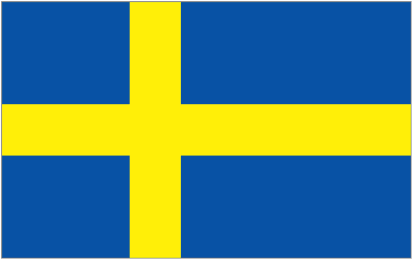
God Jul
The Christmas season in Sweden begins on 13 December - St Lucia Day. It is the tradition on this day for the eldest daughter to serve coffee and pastries to her parents in bed in the morning, whilst dressed in white and wearing a wreath of seven lit candles (usually battery powered these days!) on her head.
In the run up to Christmas, most houses will have Advent stars and candles in their windows and Christmas trees inside.
Christmas itself is celebrated on 24 December - Julafton (Christmas Eve) -with Julbord, a special Christmas meal consisting of a variety of dishes including Julskinka (ham), meat balls and fish such as herring and salmon. This is followed by Julgrot (rice pudding) which has an almond hidden in it. It is said that whoever gets the almond will be married within the year. The meal is washed down with Glogg (mulled wine).
On Julafton, presents are exchanged - those for children are delivered by Jultomten, one of Santa's elves, with the help of Julbock, a straw goat. He puts them under the tree and they are opened during the evening.
Christmas Day is mainly a religious day and many people attend early church services before going to visit friends and family.
Twelfth Night (Epiphany) is celebrated on 6 January and in many villages people will dress up as Biblical characters and go from house to house singing hymns.
The Christmas season in Sweden doesn't officially end until St Knut's Day on 13 January. This is because King Knut (who ruled Sweden from 1080 - 1086) decreed that Christmas should be celebrated for twenty days. Christmas trees are taken down on this day to signify the end of festivities.
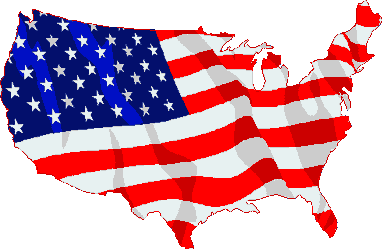
The United States is a blend of various different cultures and nowhere is this more apparent than in their celebration of Christmas which incorporates many different elements - carols from England and Australia, trees from Germany, Santa Claus from Europe and parades from Latin America - and it seems that nearly every family has it's own unique Christmas traditions.
One custom in parts of South West America is for people to light the way to their doors with 'luminaries'. These are paper bags with designs cut out of the sides and a candle placed inside. Paths are lined with the bags and after dark the candles are lit to show the way to the door.
In San Antonio, Texas these lights are placed along the River Walk, a paved walkway alongside the San Antonio River, and an old custom known as 'Las Posadas' is acted out. Two young people, representing Mary and Joseph, follow the luminaries up to a house and knock on the door. However, there is no room in the house so they move onto the next one. This is repeated several times until someone finally lets them in. Everyone then sings carols and eats the food provided by the 'innkeeper'.
In San Felipe Pueblo, 35 miles south of Santa Fe, Christmas Eve is celebrated by a unique dance. Following the sermon, dancers dressed in masks, animal skins, feathers, coral, shells, turquoise and head dresses with real antlers perform the deer, turtle, eagle and buffalo dances in front of the altar. Women carry a sprig of hakak, the sacred spruce tree, which represents eternal life and which they believed helped to create mankind.
Palm trees are decorated in Hawaii and fragrant flower leis are hung around the indoor Christmas trees. In many shopping centres 'Menehunes', the legendary little people who are supposed to have been the first inhabitants of Hawaii, are displayed.
In the run up to Christmas most houses and streets are decorated with Christmas trees and lots of coloured lights. The sound of carols and Christmas songs can be heard everywhere - especially in shops and in many parts of the US carollers will go from house to house singing Christmas songs.
Children write letters to Santa Claus, telling him what presents they would like to receive for Christmas, and many stores have their own 'Santa' for children to meet. Connecticut has a Christmas village where Santa and his elves give out gifts and in New York there is a small town called the North Pole, which was designed for Santa Claus and which has a post office, a church and a blacksmith shop to repair the shoes of the reindeer.
Christmas cards are sent to friends and relatives and most homes will have a tree which is decorated with lights, tinsel and lots of colourful ornaments - many of them handmade over the years. Presents are placed under the tree ready to be opened on Christmas Day.


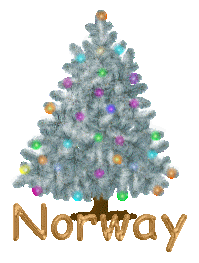
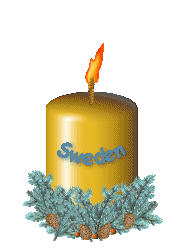




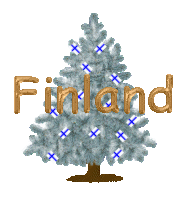





















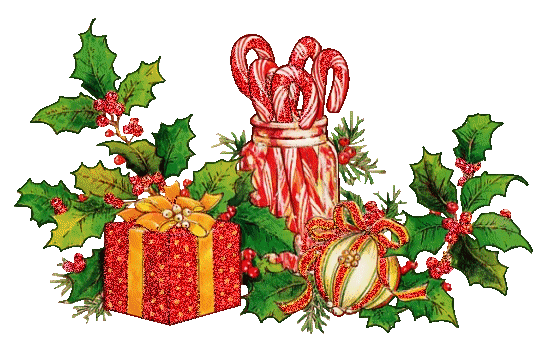
The Christmas Pickle
A Christmas Pickle Christmas Tree Decoration
The tradition of the Christmas Pickle has got to be one of the strangest modern Christmas customs in that no one is quite sure why it exists at all!
In the 1880s Woolworth stores started selling glass ornaments imported from Germany and some were in the shape of various fruit and vegetables. It seems that pickles must have been among the selection!
Around the same time it was claimed that the Christmas Pickle was a very old German tradition and that the pickle was the last ornament hung on the Christmas tree and then the first child to find the pickle got an extra present.
However, the claim that it's an old German tradition seems to be a total myth! Not many people in Germany have even heard of the Christmas Pickle! (Similarly in Russia virtually no one knows the supposedly Russian story of Babushka!)
Some families now have the tradition of hanging the pickle on the tree, with the first person/child to find it getting a present. But it probably didn't start in Germany!
There are two other rather far-fetched stories linking the pickle to Christmas.
One features a fighter in the American Civil War who was born in Bavaria (an area of what is now Germany). He was a prisoner, and starving, he begged a guard for one last pickle before he died. The guard took pity on him and gave a pickle to him. The pickle gave him the mental and physical strength to live on!
The other story is linked to St. Nicholas. It's a medieval tale of two Spanish boys traveling home from a boarding school for the holidays. When they stopped at an inn for the night, the evil innkeeper, killed the boys and put them in a pickle barrel. That evening, St. Nicholas stopped at the same inn, and found the boys in the barrel and miraculously bought them back to life!
There is an old legend about St. Nicholas rescuing boys from a barrel but the barrel was originally holding meat for pies - not pickles!
So it's most likely that an ornament salesmen, with a lot of spare pickles to sell, invented the legend of the Christmas Pickle!
The American city of Berrien Springs, MI (also known as the Christmas Pickle Capital of the World) has an annual pickle festival held during the early part of December.
Why is Christmas Day on the 25th December?
Christmas is celebrated to remember the birth of of Jesus Christ, who Christians believe is the Son of God.
The name 'Christmas' comes from the Mass of Christ (or Jesus). A Mass service (which is sometimes called Communion or Eucharist) is where Christians remember that Jesus died for us and then came back to life. The 'Christ-Mass' service was the only one that was allowed to take place after sunset (and before sunrise the next day), so people had it at Midnight! So we get the name Christ-Mass, shortened to Christmas.
Christmas is now celebrated by people around the world, whether they are Christians or not. It's a time when family and friends come together and remember the good things they have. People, and especially children, also like Christmas as it's a time when you give and receive presents!
The Date of Christmas
No one knows the real birthday of Jesus! No date is given in the Bible, so why do we celebrate it on the 25th December? The early Christians certainly had many arguments as to when it should be celebrated! Also, the birth of Jesus probably didn't happen in the year 1AD but slightly earlier, somewhere between 2BC and 7BC (there isn't a 0AD - the years go from 1BC to 1AD!).
Calendar showing 25th December
The first recorded date of Christmas being celebrated on December 25th was in 336AD, during the time of the Roman Emperor Constantine (he was the first Christian Roman Emperor). A few years later, Pope Julius I officially declared that the birth of Jesus would be celebrated on the 25th December.
There are many different traditions and theories as to why Christmas is celebrated on December 25th. A very early Christian tradition said that the day when Mary was told that she would have a very special baby, Jesus (called the Annunciation) was on March 25th - and it's still celebrated today on the 25th March. Nine months after the 25th March is the 25th December! March 25th was also the day some early Christians thought the world had been made, and also the day that Jesus died on when he was an adult.
December 25th might have also been chosen because the Winter Solstice and the ancient pagan Roman midwinter festivals called 'Saturnalia' and 'Dies Natalis Solis Invicti' took place in December around this date - so it was a time when people already celebrated things.
The Winter Solstice is the day where there is the shortest time between the sun rising and the sun setting. It happens on December 21st or 22nd. To pagans this meant that the winter was over and spring was coming and they had a festival to celebrate it and worshipped the sun for winning over the darkness of winter. In Scandinavia, and some other parts of northern Europe, the Winter Solstice is known as Yule and is where we get Yule Logs from. In Eastern europe the mid-winter festival is called Koleda.
The Roman Festival of Saturnalia took place between December 17th and 23rd and honoured the Roman god Saturn. Dies Natalis Solis Invicti means 'birthday of the unconquered sun' and was held on December 25th (when the Romans thought the Winter Solstice took place) and was the 'birthday' of the Pagan Sun god Mithra. In the pagan religion of Mithraism, the holy day was Sunday and is where get that word from!
Early Christians might have given this festival a new meaning - to celebrate the birth of the Son of God 'the unconquered Son'! (In the Bible a prophesy about the Jewish savior, who Christians believe is Jesus, is called 'Sun of Righteousness'.)
The Jewish festival of Lights, Hanukkah starts on the 25th of Kislev (the month in the Jewish calendar that occurs at about the same time as December). Hanukkah celebrates when the Jewish people were able to re-dedicate and worship in their Temple, in Jerusalem, again following many years of not being allowed to practice their religion.
Jesus was a Jew, so this could be another reason that helped the early Church choose December the 25th for the date of Christmas!
Christmas had also been celebrated by the early Church on January 6th, when they also celebrated the Epiphany (which means the revelation that Jesus was God's son) and the Baptism of Jesus. Now Epiphany mainly celebrates the visit of the Wise Men to the baby Jesus, but back then it celebrated both things! Jesus's Baptism was originally seen as more important than his birth, as this was when he started his ministry. But soon people wanted a separate day to celebrate his birth.
Most of the world uses the 'Gregorian Calendar' implemented by Pope Gregory XIII in 1582. Before that the 'Roman' or Julian Calendar was used (named after Julius Caesar). The Gregorian calendar is more accurate that the Roman calendar which had too many days in a year! When the switch was made 10 days were lost, so that the day that followed the 4th October 1582 was 15th October 1582. In the UK the change of calendars was made in 1752. The day after 2nd September 1752 was 14th September 1752.
Many Orthodox and Coptic Churches still use the Julian Calendar and so celebrate Christmas on the 7th January (which is when December 25th would have been on the Julian calendar). And the Armenian Apostolic Church celebrates it on the 6th January! In some part of the UK, January 6th is still called 'Old Christmas' as this would have been the day that Christmas would have celebrated on, if the calendar hadn't been changed. Some people didn't want to use the new calendar as they thought it 'cheated' them out of 11 days!
Christians believe that Jesus is the light of the world, so the early Christians thought that this was the right time to celebrate the birth of Jesus. They also took over some of the customs from the Winter Solstice and gave them Christian meanings, like Holly, Mistletoe and even Christmas Carols!
St Augustine was the person who really started Christmas in the UK by introducing Christianity in the 6th century. He came from countries that used the Roman Calendar, so western countries celebrate Christmas on the 25th December. Then people from Britain and Western Europe took Christmas on the 25th December all over the world!
So when was Jesus Born?
There's a strong and practical reason why Jesus might not have been born in the winter, but in the spring or the autumn! It can get very cold in the winter and it's unlikely that the shepherds would have been keeping sheep out on the hills (as those hills can get quite a lot of snow sometimes!).
During the spring (in March or April) there's a Jewish festival called 'Passover'. This festival remembers when the Jews had escaped from slavery in Egypt about 1500 years before Jesus was born. Lots of lambs would have been needed during the Passover Festival, to be sacrificed in the Temple in Jerusalem. Jews from all over the Roman Empire travelled to Jerusalem for the Passover Festival, so it would have been a good time for the Romans to take a census. Mary and Joseph went to Bethlehem for the census (Bethlehem is about six miles from Jerusalem).
In the autumn (in September or October) there's the Jewish festival of 'Sukkot' or 'The Feast of Tabernacles'. It's the festival that's mentioned the most times in the Bible! It is when Jewish people remember that they depended on God for all they had after they had escaped from Egypt and spent 40 years in the desert. It also celebrates the end of the harvest. During the festival, Jews live outside in temporary shelters (the word 'tabernacle' come from a latin word meaning 'booth' or 'hut').
Many people who have studied the Bible, think that Sukkot would be a likely time for the birth of Jesus as it might fit with the description of there being 'no room in the inn'. It also would have been a good time to take the Roman Census as many Jews went to Jerusalem for the festival and they would have brought their own tents/shelters with them! (It wouldn't have been practical for Joseph and Mary to carry their own shelter as Mary was pregnant.)
The possibilities for the Star of Bethlehem seems to point either spring or autumn.
So whenever you celebrate Christmas, remember that you're celebrating a real event that happened about 2000 years ago, that God sent his Son into the world as a Christmas present for everyone!
As well as Christmas and the solstice, there are some other festivals that are held in late December. Hanukkah is celebrated by Jews; and the festival of Kwanzaa is celebrated by some Africans and African Americans takes place from December 26th to January 1st.




Traditions of Christmas Bells
Golden Bells
Bells, especially Church Bells, have traditionally been associated with Christmas for a long time. In the Anglican and Catholic churches, the church day starts at sunset, so any service after that is the first service of the day. So a service on Christmas Eve after sunset is traditionally the first service of Christmas day! In churches that have a Bell or Bells, They are often rung to signal the start of this service.
In some churches in the UK, it is traditional that the largest bell in the church is rung four times in the hour before midnight and then at midnight all the bells are rung in celebration.
In the Catholic Church, Christmas is the only time that Mass is allowed to be held at Midnight. This is because in the early church, it was believed that Jesus was born at midnight, although there has never been any proof of this! A lot of Churches have midnight services on Christmas Eve, although not every church will have a mass or communion as part of the service.
In many Catholic countries such as France, Spain and Italy, the midnight mass service is very important and everyone tries to go to a service.
In Victorian times, it was very fashionable to go carol singing with small handbells to play the tune of the carol. Sometimes there would only be the bells and no singing! Handbell ringing is still popular today.
Christmas Candles
There are many different reasons why candles are associated with Christmas, although no one knows when they first became connected!
They were used during ancient winter solstice celebrations a way of remembering that spring would soon come.
One of the earliest records of candles being used at Christmas is from the middle ages, where a large candle was used to represent the star of Bethlehem. Jesus is sometimes called 'the Light of the World' by Christians. This might have started the custom of the Advent Crown and Advent Candles.
Candles are also used during Hanukkah, the Jewish Festival of light which is also celebrated during winter. During the eight nights of Hanukkah, a candle is lit in a special menorah (candelabra) called a 'hanukkiyah'.
Candles are also used in the modern winter festival Kwanzaa, where a special candle holder called a kinara, that holds seven candles is used.
Perhaps the most famous use of candles at Christmas are Carols by Candlelight Services. These are services when the church is only lit by candles.
Candles were also originally used to decorate Christmas Trees, until safer electric lights were invented!
In some parts of Ireland, it was traditional to have a Yule candle instead of a Yule Log.
In Southern India, Christians often put small oil burning clay lamps on the flat roofs of their homes to celebrate Christmas. Christians in China use paper lanterns to decorate their Christmas trees. Candles are also used as part of the St. Lucia's or St. Lucy's day celebrations in Sweden.
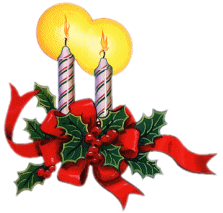
The Colors of Christmas
There are several colors which are traditionally associated with Christmas. This site uses Red, Green and Gold. But why do we have them and what do the colors represent?
Most the colors and their meanings come from the western/northern european traditions and customs, when Christmas is in the middle of winter and it's dark and cold.
Green
Evergreen plants, like Holly, Ivy and Mistletoe have been used for thousands of years to decorate and brighten up buildings during the long dark winter. They also reminded people that spring would come and that winter wouldn't last forever!
The Romans would exchange evergreen branches during January as a sign of good luck. The ancient Egyptians used to bring palm branches into their houses during the mid winter festivals.
In many parts of Europe during the middle ages, Paradise plays were performed, often on Christmas Eve. They told Bible stories to people who couldn't read. The 'Paradise Tree' in the garden of eden in the play was normally a pine tree with red apples tied to it.
Now the most common use of green at Christmas are Christmas Trees.
Red
As mentioned above, an early use of red at Christmas were the apples on the paradise tree. They represented the fall of Adam in the plays.
Red is also the color of Holly berries, which is said to represent the blood of Jesus when he died on the cross.
Red is also the color of Bishops robes. These would have been worn by St. Nicholas and then also became Santa's uniform!
Gold
Gold is the color of the Sun and light - both very important in the dark winter. And both red and gold are the colors of fire that you need to keep you warm.
Gold was also one of the presents brought to the baby Jesus by one of the wise men and traditionally it's the color used to show the star that the wise men followed.
Silver is sometimes used instead of (or with) gold. But gold is a 'warmer' color.
White
White is often associated with purity and peace in western cultures. The snow of winter is also very white!
White paper wafers were also sometimes used to decorate paradise trees. The wafers represented the bread eaten during Christian Communion or Mass, when Christians remember that Jesus died for them.
White is used by most churches as the color of Christmas, when the altar is covered with a white cloth (in the Russian Orthodox Church Gold is used for Christmas).
Blue
The color blue is often associated with Mary, the mother of Jesus. In medieval times blue dye and paint was more expensive than gold! So it would only be worn by Royal families and very rich people. Mary was often painted wearing blue to show she was very important.
Blue can also represent the color of the sky and heaven.
During Advent, purple and sometimes blue is used in most churches fort he colour of the altar cloth (in the Russian Orthodox Church red is used for advent).



More Christmas Information Below At WhyChristmas?Com









































































































































